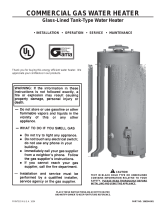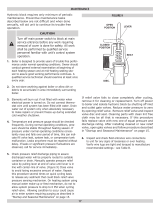
17
TABLE 5, COMBINED VENT SIZING TABLES
MODEL HW-300 BOILER
Input: 300,000 Btuh Draft Hood Outlet 8"
Required Connector or Smoke Pipe Diameter
Connector
Rise in Feet
Total Vent Height (Measured in Feet Above Draft Hood)
10 15 20 30 40 50 60 80 100
Connector Diameter (in Inches)
1 10 10 10 10 10 10 10 10 10
2 10 10 10 10 10 10 10 10 10
3 10 10 10 10 10 10 10 10 10
4 or more
Number
if Units
Combined
Total Input
Btuh x 1000
Total Vent Height (Measured in Feet Above Draft Hood)
10 15 20 30 40 50 60 80 100
Manifold and Common Vent Diameter (in Inches)
2 600 14 12 12 12 10 10 10 10 10
3 900 16 14 14 14 12 12 12 12 12
4 1200 18 16 16 14 14 14 14 12 12
MODEL HW-399 BOILER
Input: 399,000 Btuh Draft Hood Outlet 10"
Required Connector or Smoke Pipe Diameter
Connector
Rise in Feet
Total Vent Height (Measured in Feet Above Draft Hood)
10 15 20 30 40 50 60 80 100
Connector Diameter (in Inches)
1 12 12 12 12 12 12 12 12 12
2 12 12 12 10 10 10 10 10 10
3 12 10 10 10 10 10 10 10 10
4 or more 10 10 10 10 10 10 10 10 10
Number
if Units
Combined
Total Input
Btuh x 1000
Total Vent Height (Measured in Feet Above Draft Hood)
10 15 20 30 40 50 60 80 100
Manifold and Common Vent Diameter (in Inches)
2 798 14 14 14 12 12 12 12 12 12
3 1197 18 16 16 14 14 14 14 14 12
4 1596 20 20 18 16 16 16 14 14 14
MODEL HW-420 BOILER
Input: 420,000 Btuh Draft Hood Outlet 10"
Required Connector or Smoke Pipe Diameter
Connector
Rise in Feet
Total Vent Height (Measured in Feet Above Draft Hood)
10 15 20 30 40 50 60 80 100
Connector Diameter (in Inches)
1 12 12 12 12 12 12 12 12 12
2 12 12 12 10 10 10 10 10 10
3 12 10 10 10 10 10 10 10 10
4 or more 10 10 10 10 10 10 10 10 10
Number
if Units
Combined
Total Input
Btuh x 1000
Total Vent Height (Measured in Feet Above Draft Hood)
10 15 20 30 40 50 60 80 100
Manifold and Common Vent Diameter (in Inches)
2 840 14 14 14 12 12 12 12 12 12
3 1260 18 16 16 14 14 14 14 14 12
4 1680 20 20 18 16 16 16 14 14 14
MODEL HW-520 BOILER
Input: 520,000 Btuh Draft Hood Outlet 10"
Required Connector or Smoke Pipe Diameter
Connector
Rise in Feet
Total Vent Height (Measured in Feet Above Draft Hood)
10 15 20 30 40 50 60 80 100
Connector Diameter (in Inches)
1 14 14 14 12 12 12 12 12 12
2 12 12 12 12 12 12 12 12 12
3 12 12 12 12 10 10 10 10 10
4 or more 12 12 12 12 10 10 10 10 10
Number
if Units
Combined
Total Input
Btuh x 1000
Total Vent Height (Measured in Feet Above Draft Hood)
10 15 20 30 40 50 60 80 100
Manifold and Common Vent Diameter (in Inches)
2 1040 16 16 14 14 14 14 12 12 12
3 1560 20 18 18 16 16 14 14 14 14
4 2080 22 22 20 18 18 18 16 16 14
5 2600 26 24 22 20 20 18 18 18 18
6 3120 28 26 24 22 22 20 20 18 18
7 3640 30 28 26 24 24 22 22 20 20
8 4160 32 30 28 26 24 24 22 22 20
MODEL HW-610 BOILER
Input: 610,000 Btuh Draft Hood Outlet 12"
Required Connector or Smoke Pipe Diameter
Connector
Rise in Feet
Total Vent Height (Measured in Feet Above Draft Hood)
10 15 20 30 40 50 60 80 100
Connector Diameter (in Inches)
1 16 14 14 14 14 14 14 14 14
2 14 14 14 14 14 12 12 12 12
3 14 14 12 12 12 12 12 12 12
4 or more 12 12 12 12 12 12 12 12 12
Number
if Units
Combined
Total Input
Btuh x 1000
Total Vent Height (Measured in Feet Above Draft Hood)
10 15 20 30 40 50 60 80 100
Manifold and Common Vent Diameter (in Inches)
2 1220 18 18 16 16 14 14 14 14 14
3 1830 22 20 20 18 18 16 16 16 14
4 2440 26 24 22 20 20 18 18 18 16
5 3050 28 26 26 24 22 22 20 20 18
6 3660 32 28 28 26 24 24 22 22 20
7 4270 34 32 30 28 26 24 24 22 22
8 4880 36 34 32 30 28 26 26 24 24
9 5490 38 36 34 30 30 28 28 26 24
10 6100 40 38 36 32 30 30 28 26 26
11 6710 42 38 38 34 32 30 28 28 26
12 7320 44 42 38 36 34 32 32 30 28
MODEL HW-670 BOILER
Input: 660,000 or 670,000 Btuh Draft Hood Outlet 12"
Required Connector or Smoke Pipe Diameter
Connector
Rise in Feet
Total Vent Height (Measured in Feet Above Draft Hood)
10 15 20 30 40 50 60 80 100
Connector Diameter (in Inches)
1 16 14 14 14 14 14 14 14 14
2 14 14 14 14 14 12 12 12 12
3 14 14 12 12 12 12 12 12 12
4 or more 12 12 12 12 12 12 12 12 12
Number
if Units
Combined
Total Input
Btuh x 1000
Total Vent Height (Measured in Feet Above Draft Hood)
10 15 20 30 40 50 60 80 100
Manifold and Common Vent Diameter (in Inches)
2 1220 18 18 16 16 14 14 14 14 14
3 1830 22 20 20 18 18 16 16 16 14
4 2440 26 24 22 20 20 18 18 18 16
5 3050 28 26 26 24 22 22 20 20 18
6 3660 32 28 28 26 24 24 22 22 20
7 4270 34 32 30 28 26 24 24 22 22
8 4880 36 34 32 30 28 26 26 24 24
9 5490 38 36 34 30 30 28 28 26 24
10 6100 40 38 36 32 30 30 28 26 26
11 6710 42 38 38 34 32 30 28 28 26
12 7320 46 44 40 38 36 34 34 32 30
Known: (5) model HW-610 boilers. (See illustration).
Connector rise - 2' (Note 1' is minimum). Total vent
height 30'.
Problem: Determine diameter of connector, manifold and
common vent.
Procedure: Enter the top of the HW-610 table (total vent height)
at 30' and the side at 2' (connector rise). A 14"
connector diameter is indicated for each connector
rise.
To determine the manifold and common vent size, enter table on this
page (total vent height) at 30 and the side at 5 boilers. A manifold
diameter of 24" (610 mm) is indicated.






















